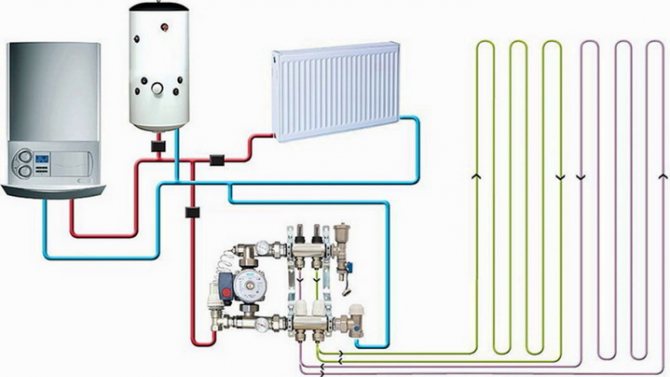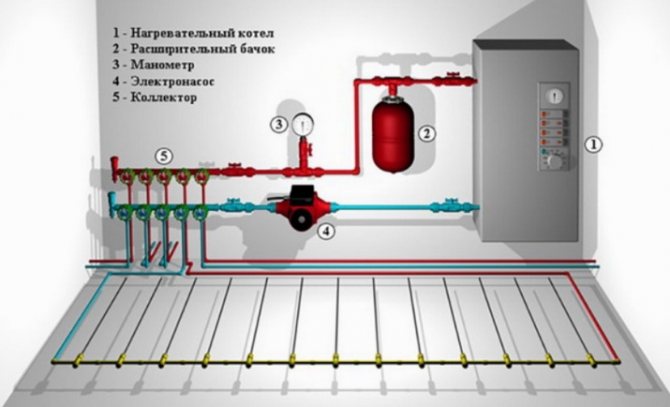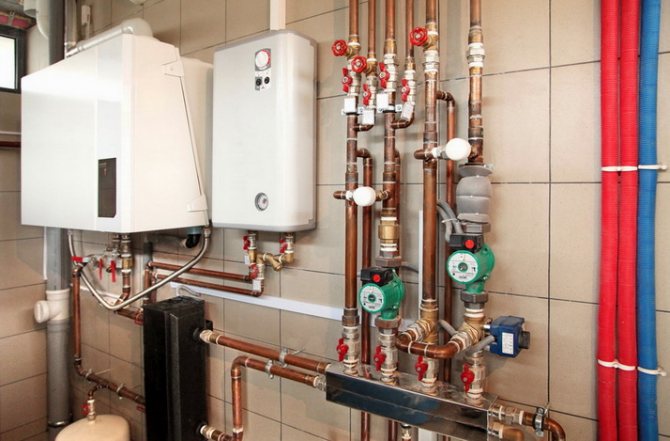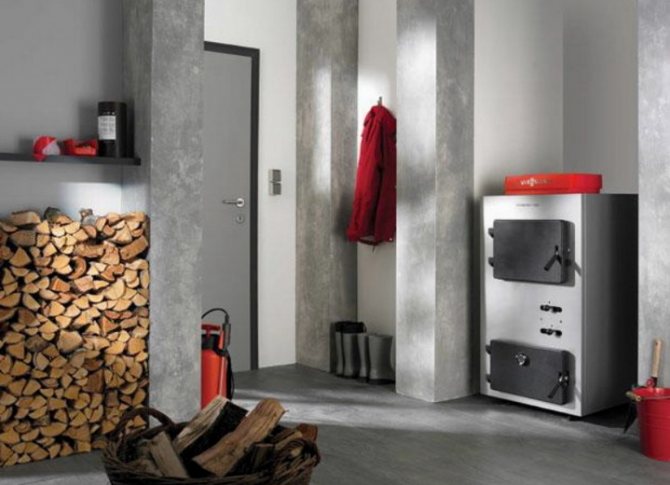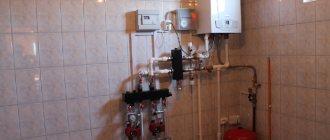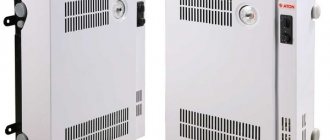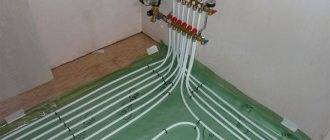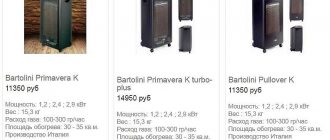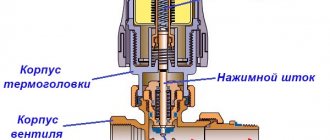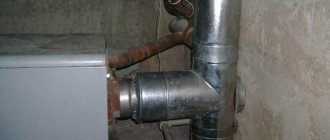For a new private house, for a cottage or a summer cottage, equipment of the "warm floor" heating system will become a successful and effective way of heating. The information available today suggests that, in terms of its efficiency, such a heating system for residential premises is quite effective. Water underfloor heating today is becoming more and more popular in private households, given the large selection of technical means, materials and devices necessary for the installation of such a system. The quality of heating in any case depends on the heat source. If there are no special questions with gas and electric boilers during the installation of a warm floor, then a bundle of a solid fuel boiler and underfloor heating will make you tinker.
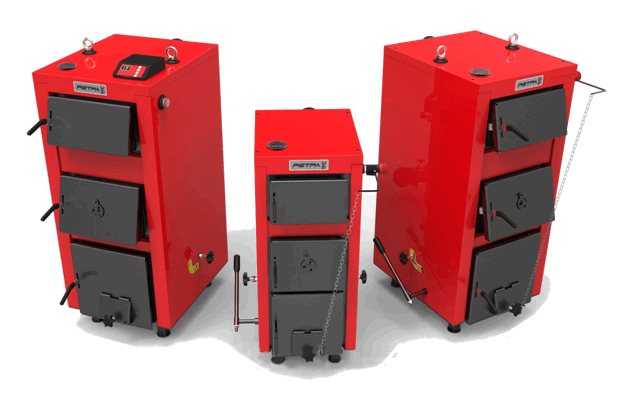
The main reason lies in the absence of a clear and effective mechanism for adjusting the heating temperature of the coolant. The boiler water temperature, which diverges along the floor heating circuit, must not exceed the permissible parameters. The slightest malfunction of the heating device and on your floor, right in the room, you can cook food. Let's consider the problem from different angles.
Underfloor heating - its efficiency and compatibility with solid fuel boilers
The main advantage that a heated floor has in comparison with other heating methods is the uniform heating area of the internal space. In a room that is equipped with a warm floor, there are practically no warm or cold zones. Heated flooring radiates heat. Warm air currents rise evenly upward, displacing cooler air. Due to natural convection, regular air exchange occurs in the heated room.
Important! In terms of its efficiency, underfloor heating, powered by a solid fuel heater, is only slightly inferior to similar systems powered by gas boilers.
Due to the fact that the temperature of the coolant in the heating circuit for a water underfloor heating is lower than with convection heating, a significant saving of the fuel resource is achieved. In the case of solid fuel boilers, this fact is important. The heated screed is a kind of heat accumulator, which is capable of releasing the accumulated thermal energy into the internal space for a long time. Even when the boiler is stopped, the underfloor heating remains warm for a rather long time.
The proposed video describes in detail and shows the main technical subtleties and nuances that arise during the installation of this heating scheme.
For those who choose a home heating system underfloor heating from a solid fuel boiler, you need to take into account a whole range of nuances and technical aspects. Competent selection of a heating device for the heating system, correct piping and connection, will allow you to get the most expected result from the operation of heating equipment. Solid fuel boilers, due to their high inertia, represent a warm floor for the heating system, a "double-edged sword". On the one hand, it is good when the boiler cools down for a long time and hot coolant continues to flow into the pipeline for some time. This will allow for a while to avoid a rapid drop in temperature inside living quarters.
On the other hand, it is not possible to quickly reduce the heating temperature during the operation of solid fuel boilers. The system is difficult to adjust.It is required to install additional protective devices to compensate for the lack of technological flexibility of heating equipment operating on wood or coal.
The list of disadvantages associated with boiler equipment that runs on wood or coal can be continued:
- the need for regular loading of the next batch of fuel (at least at least once a day);
- cleaning and cleaning of the boiler is carried out manually, which will also take a lot of time;
- the need to store a certain stock of coal or firewood in the immediate vicinity of the fuel unit;
- regular checking of the chimney's performance and the state of ventilation in the house;
- a sharp drop in the efficiency of the heating system due to a decrease in the boiler power.
On a note: The last point for underfloor heating is not so relevant, recalling the ability of a concrete screed to play the role of a heat accumulator.
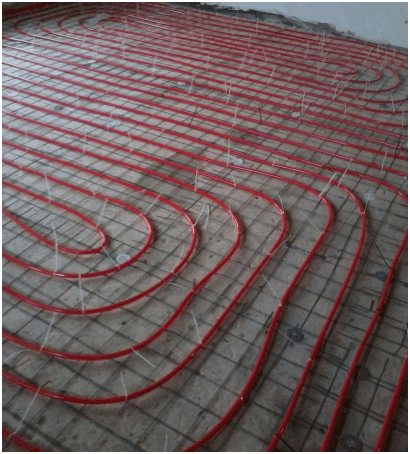

Despite the obvious difficulties, the water floor in a country house, powered by a solid fuel unit, has its positive aspects. The first place here is - autonomy. For a country house, such a plus in the heating system is, if not the most important, then the key. The economy and efficiency of heating units operating on wood, woodworking waste, coal or fuel briquettes are also important aspects that should be paid attention to.
What boilers can be combined with a warm floor
The best boiler for floor heating is an electric boiler. Moreover, regardless of whether it is a heating element, induction or electrode. It has optimum efficiency even at low power levels. In a small house, such equipment can be connected directly to the underfloor heating system. In large rooms, it is better to connect using a special distribution and mixing unit.
The boiler works automatically and practically does not need human control. It is easy to install and easy to maintain.
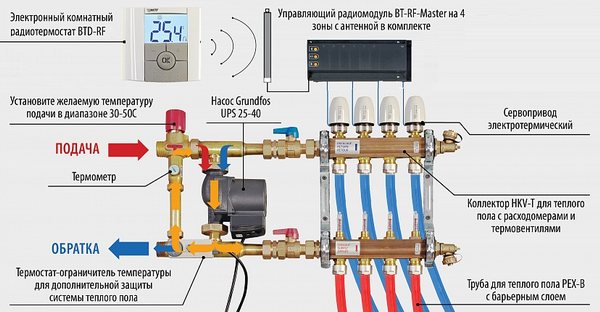

Autonomous circulation group Isoterm Watts 44.02.070
You can also use condensate gas boilers, which can work effectively with a slight heating of the coolant. But conventional gas units require the installation of a mixing unit, in which control elements will be provided. This is a great option for combining radiator heating and underfloor heating systems.
Solid fuel and liquid fuel boilers are not the best option, although they can also be used to organize a floor heating system. They require the installation of a mixing unit with thermometers, controllers and other additional equipment. Yes, and it is very difficult to debug the desired temperature with their help - either they give out too hot a coolant, then too cold.
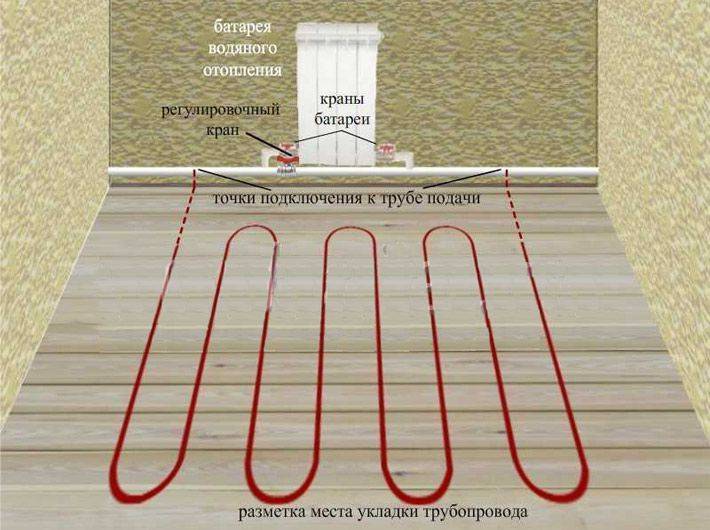

Principles of technology for connecting a warm floor to the heating system
Methods for connecting a solid fuel boiler to a floor heating system
Solving the main problem
The main problem is that the majority of solid fuel heating devices used in private houses lack the automation that we are accustomed to when operating gas or electric units. In most models, the boiler is stopped in a semi-automatic mode, the blower is closed, the boiler is extinguished. Is this principle of operation of a heating boiler suitable for underfloor heating to work effectively in the house?
From a technological point of view, a warm floor is the equipment for which there is a fundamental limitation on the heating temperature. Overheating of the floor will lead to the fact that you will have to forget about the comfort in the house for a while. A working boiler produces an order of magnitude more heat energy than is needed to supply the heating circuit.The problem can be partially solved by installing a mixing valve or an electric pump in the system, which will circulate the hot coolant through the pipes. However, in this case, the main advantage of solid-fuel devices, their autonomy, is lost.
For reference: the recommended temperature of the floor surface in residential premises should not exceed 29-30 0 C. The maximum threshold of 33 degrees is allowed in bathrooms, in toilets, where the flooring is usually made of tiled or ceramic tiles.
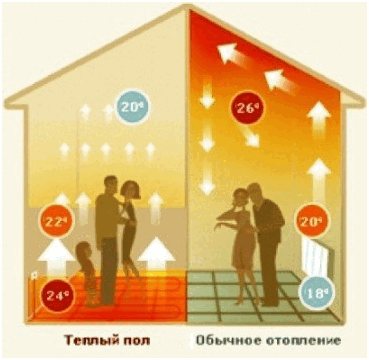

Situations in winter are not uncommon, when, in case of bad weather, the power supply of residential buildings is disrupted. In such a situation, stopping the circulation pump threatens not only overheating of the heating device, but also the destruction of the main components and elements of the heating system. The restoration of the power supply will lead to the fact that the overheated coolant will again begin to flow into the heating circuit, which is not able to withstand such temperatures. As a result, a breakthrough and failure of the entire heating system. What this is fraught with, you can imagine!
In order to protect yourself from such troubles, it is better to equip an autonomous heating system with additional devices for removing excess heat energy. It will not be possible to extinguish the boiler immediately and it will not be possible to immediately reduce the heating temperature, especially at night. Additional devices can do this work for you.
Method one. Connecting heating radiators
Important! Without installing a three-way valve (usually 3-8 pieces according to the number of circuits), the operation of your heating system will constantly be at risk. The mixing unit, equipped with three-way valves, will be able to solve the problem of cooling the heated coolant at the right time.
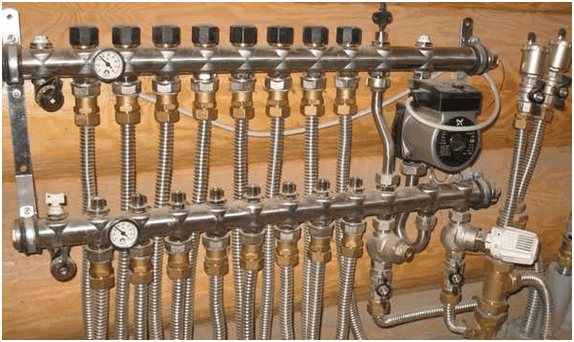

Having at our disposal a wood-fired heating boiler for underfloor heating, it is enough to install additional heating radiators in the house. The main task that is assigned to them is to compensate for the excess heat coming from a working heating device. The hot coolant will freely circulate through the batteries, giving off excess heat energy. Usually, 1-2 radiators are installed for this purpose, in rooms that are periodically visited by the inhabitants of the house (corridor, basement room, dressing rooms).
How to choose a boiler?
The owners usually select a heating unit for a private house for the benefit of using any energy carrier from those that are available. This approach is correct, and it must be followed when choosing a boiler for underfloor heating (TP). That is, when choosing a suitable heater, the following factors must be taken into account:
- what energy carrier is the most profitable;
- what heat power is required;
- how electricity is supplied in the region of residence, are there frequent blackouts;
- comfort during operation, including ease of maintenance;
- how easily the future heat source fits into the underfloor heating circuits.
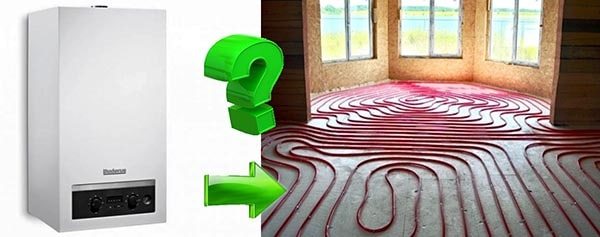

In the context of this article, the last point is of particular interest. The fact is that no manufacturer produces special boilers for underfloor heating. In some models of gas heat generators, you can find only the function of working with water heated floors and nothing more.
The main difference between a radiator heating system and floor heating circuits is the temperature of the coolant. For supply to radiators, water is heated to a maximum of 85 ° С, while in pipes of water floors it should not exceed 55 ° С.
The optimum temperature schedule for underfloor heating is 35–45 ° C in the supply and 25–35 ° C in the return. If a warm floor and radiators, supplied with heated water from one boiler, participate in the heating of the house, then this does not affect the choice of the heat generator.Another issue is when batteries are not provided, and the boiler plant should only serve a low-temperature floor heating system.
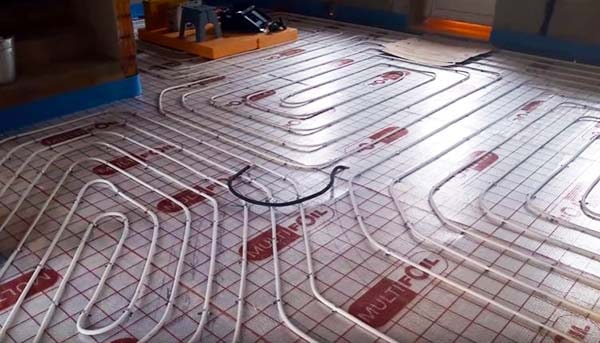

Not every heat source is capable of maintaining a coolant temperature of 30-40 ° C. The issue is solved using various methods of piping the heating unit. The complexity of joining depends on the type of boiler used for a warm water floor:
- gas wall or floor;
- electric;
- solid fuel;
- automatic pellet or coal.
How compatible these boilers are with underfloor heating and how to connect them correctly, we will consider separately for each of the varieties.
Choosing a solid fuel boiler for a warm floor
Having decided for yourself to create maximum comfort and coziness in the house with the help of a solid fuel boiler and a "warm floor" heating system, you should not build any special illusions. This circuit is so sensitive and gentle to work, so you will need constant attention and control to the operating equipment.
In order to at least somehow facilitate your task in the future, it is necessary to strictly treat the choice of a solid fuel unit.
It is possible to use a traditional wood-burning unit, only then you will have to spend more time on its maintenance. The situation looks better with boiler equipment equipped with an automated fuel supply mechanism. Pellet solid fuel apparatuses are good in this regard. By installing a pellet hopper next to the heating unit, you can free up a lot of time for yourself.
For example: loading the bunker, on average 1-2 m3 with fuel in the form of pellets, will allow a 50 kW boiler to work without interruption for almost a week. The heating system is practically protected from defrosting during your long absence.
To balance the disadvantages characteristic of traditional solid fuel units, pyrolysis-type boilers will allow.
Even with manual loading, you only need to fully load the unit firebox 1-2 times. The duration of fuel burning in the furnace, the presence of a heat accumulator in the system, the physical properties of the concrete screed in the complex will provide the necessary and comfortable temperature inside the living quarters.
Wood-fired solid fuel boilers
The boiler has an electric air blower, which is electronically controlled by a thermostat. As a result of a change in the amount of air, the power of the boiler during combustion changes depending on the temperature of the coolant.
The electronic system displays various indicators to monitor the boiler operating mode. The boiler has an indicator of the minimum amount of fuel in the firebox and gives a signal to the owner. The design of the boiler provides for the possibility of additional fuel loading without stopping the combustion process.
Equipment manufacturers produce universal combined boilers
, which can burn fuel in two modes - with air supply either from below or from above. The cost of such boilers is naturally higher.
Design and principle of operation
The pellet boiler consists of a fuel hopper, automation and burner. Pellets are delivered through an external screw to the pre-furnace, and from it through an internal screw they are fed to the burner nozzle. After the granules hit the nozzle, there is automatic ignition and the supplied pellets are burned completely.
In terms of calorific value, combustion of 1 kg of pellets is comparable to half a liter of diesel fuel and amounts to 5 kW / h. When compared with firewood, due to the high density of the pellets, their combustion is much more efficient and productive, excluding the possibility of spontaneous combustion. In addition, ash cleaning can be done much less frequently, reducing this process to once a week. By using pellets as fuel, carbon dioxide emissions into the atmosphere are reduced, which leads to a decrease in the greenhouse effect.
Installation of a pellet boiler requires compliance some rules thanks to which it will be possible to avoid possible alterations during its operation:
- it is more expedient to install the boiler in a separate room, for example, a basement or an annex;
- the flooring in the boiler room must be made of ceramic tiles or concrete;
- there must be enough free space in the room that will be used as a boiler room to be able to repair and maintain the boiler;
- the room should be dry, well ventilated, with a constant temperature within +10 0 C.
An important indicator for any type of boiler equipment is its Efficiency... In order to more clearly understand the efficiency of a pellet boiler, let us compare it with other equipment used to heat a house. So the efficiency of wood is within 35%, natural gas - 87.1%, electric energy is 97%, and burned pellets in the range from 86% to 93%, depending on the model of the pellet boiler.
Automatic solid fuel boilers
Automatic solid fuel boilers are on sale. It is more correct to call them semi-automatic, since the boiler still requires periodically certain actions from a person, albeit not every day.
You can get acquainted with the device and the principle of operation of an automatic solid fuel boiler if you watch this video clip:
The fuel for the automatic boiler can be granular coal with a fraction of 5 - 25 mm. or wood pellets - pellets, as well as pellets from other combustible materials - peat and waste of plant and animal origin.
The need to use only granular fuel
for combustion in automatic boilers, causes certain difficulties for the owners of the house. The cost of such fuel on the market is noticeably higher than that of conventional chopped wood or coal.
In automatic boilers, manufacturers often provide for the possibility of replacing the burner for granular fuel, with another burner for gas or liquid fuel. Grizzlies can be installed instead of the burner. In this version, the boiler turns into an ordinary wood-fired boiler.
Granular fuels are usually sold in bags. Fuel is easily and dust-free loaded into the boiler hopper. One loading of the bunker is enough for 3 - 10 days of boiler operation.
After firing up at the beginning of the heating season, combustion in an automatic boiler takes place continuously
... An automatic boiler can operate in two modes:
- Active combustion mode
, at which the boiler power can be in the range of 10 - 100% of the nominal. - Combustion support mode,
when the power of the boiler is selected so as to ensure the temperature of the heating agent in the boiler circuit of about 55 degrees C. The automatic controller switches the boiler to support mode when there is no heat extraction from the heating circuit. This mode is necessary to protect the boiler from low-temperature corrosion (see below for details), and also ensures the constant readiness of the boiler to resume active combustion.
During the operation of the boiler, it is necessary:
- Monitor the filling of the bunker and load fuel into the bunker once every 3 to 7 days.
- Remove ash from the removable ash drawer every 2 to 4 days.
- Once a week, clean the inner surfaces of the boiler from deposits with a special tool.
- Every year, before the start of the heating season, clean and check the boiler flue.
Automatic control mode
Pellet granules are stored in free-standing bunkerwhich is connected to the combustion chamber. Automation allows you to set a weekly program for feeding pellets into the boiler.In addition, according to the established program, the automation will turn on or off the burner, which saves fuel consumption and maintains the specified temperature regime depending on the time of day. Control can be done either with the remote control or using the buttons on the display.
The hopper with a volume of 200 to 300 liters provides continuous operation of the boiler for three days. For uninterrupted operation of the average boiler power in the range of 25 kW, the daily rate is 5 kg. It is possible to install an external hopper, which will significantly increase the volume of pellet loading, thereby increasing the operating time of the boiler without your intervention. Responsible for the operation of the burner control system, pellets are fed into the combustion chamber in small batches, which excludes the possibility of overheating. If you need to turn off the boiler, then after pressing the function button, its operation will automatically stop after 5-10 minutes, which is required for the complete combustion of the loaded batch of pellets.
Solid fuel unit connection
Have you chosen to heat your home with wood using underfloor heating without connecting radiators? Get ready for a significant investment in the piping of a solid fuel boiler, since in this situation you cannot do without a buffer tank. The reason is that wood-fired heaters need to dump heat somewhere, otherwise the water jacket of the unit may boil.
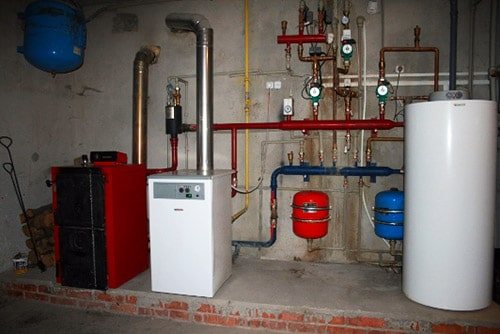

Moreover, a solid fuel heat generator is not able to heat the coolant only up to 40 ° C, its minimum operating temperature is 55 ° C. If it is lower, condensation forms in the combustion chamber, which adversely affects the metal walls. Even in a non-corrosive cast iron boiler, condensation builds up a layer of deposits that impedes the efficient combustion of fuel.
In order for a solid fuel boiler to function with maximum efficiency, and you burn firewood with the greatest benefit, you need to maintain the temperature of the coolant at 80-90 ° C, which is absolutely incompatible with warm floors. This means that a buffer tank is needed - a heat accumulator.
During the maximum burning of firewood, excess heat will accumulate in the heat accumulator, and the floor heating system will gradually select the required amount using the mixing unit, as shown in the diagram:


Cut-off valves for the heat accumulator are conventionally not shown in the diagram.
According to the proposed scheme, you can connect any solid fuel or gas boiler, this is the best of the existing options, although not the cheapest. It is recommended to connect pellet and coal automated heat generators in the same way. Calculation and selection of the volume of the used heat accumulator is a separate topic discussed here.
Environmental Safety
Thanks to special design of pellet boilers, nothing threatens the ecology of your premises. In them, the circuit through which the air is supplied for complete combustion of the fuel is located separately from the circuit through which the room is heated. Due to this design, there is no "burnout»Oxygen and therefore you will always feel comfortable. Some users additionally take air from the boiler room, thereby dehumidifying and ventilating it. In addition, to advantages a pellet boiler includes the following factors:
- energy saving and low noise fan, is able to provide uniform efficient circulation of warm air;
- low power consumption, within 60 watts, for the operation of automation and fan;
- small volume of ash and soot, in comparison with solid fuel boilers;
- the boiler drum does not heat up, therefore, it is absolutely safe for animals and small children;
- implementation automatic fuel loading from the bunker;
- intelligent control system, timer and thermostat control and ensure continuous operation of the boiler, depending on the set program.
Protection of a solid fuel boiler from overheating
In a solid fuel boiler, burning fuel, and the boiler itself, has a rather large mass. Therefore, the heat release process in the boiler has a large inertia. The combustion of fuel and the heating of water in a solid fuel boiler cannot be instantly stopped by stopping the fuel supply, as is done in a gas boiler.
Solid fuel boilers, more than others, are prone to overheating of the coolant
- boiling water, if heat extraction is lost, for example, when the water circulation in the heating system suddenly stops, or more heat is released in the boiler than is consumed.
Boiling water in the boiler leads to an increase in temperature and pressure in the heating system with all serious consequences - destruction of the heating system equipment, injury to people, damage to property.
Modern closed heating systems with a solid fuel boiler are especially prone to overheating, since they contain a relatively small volume of coolant.
In heating systems, polymer pipes, manifold control and distribution units, various taps, valves and other fittings are usually used. Most elements of the heating system are very sensitive to overheating of the coolant and pressure surges caused by the boiling of water in the system.
A solid fuel boiler in the heating system must be protected against overheating of the coolant.
To protect the solid fuel boiler from overheating in a closed heating system that has no connection to the atmosphere, two steps must be taken:
- Shut off the combustion air supply to the boiler furnace, so that as soon as possible reduce the intensity of fuel combustion.
- Provide coolant cooling
at the outlet of the boiler and prevent the water temperature from rising to a boil. Cooling should continue until the heat release is reduced to a level at which the boiling of water becomes impossible.
Let's consider how to protect the boiler from overheating, using the example of the heating circuit, which is shown below.
Diagram of connecting a solid fuel boiler to a closed heating system
| Diagram of a closed heating system with a solid fuel boiler. 1 - boiler safety group (safety valve, automatic air vent, pressure gauge); 2 - a tank with a water supply for cooling the coolant when the boiler overheats; 3 - float shut-off valve; 4 - thermal valve; 5 - connection group of the expansion membrane tank; 6 - unit for coolant circulation and boiler protection against low-temperature corrosion (with a pump and a three-way valve); 7 - heat exchanger for overheating protection. |
Boiler overheating protection works as follows.
When the temperature of the coolant rises above 95 degrees, the thermostat on the boiler closes the air supply damper to the boiler combustion chamber.
The thermal valve, pos. 4, opens the supply of cold water from the tank, pos. 2, to the heat exchanger, pos. 7. Cold water flowing through the heat exchanger cools the heating medium leaving the boiler, preventing boiling.
The supply of water in the tank (pos. 2) is necessary in the event of a lack of water in the water supply system, for example, during a power outage. Often, a common storage tank is installed in the water supply system at home. Then the water for cooling the boiler is taken from this tank.
A heat exchanger to protect the boiler from overheating and cool the coolant, item 7 and a thermal valve, item 4, is usually built into the boiler drum by boiler manufacturers. This has become the standard equipment for boilers designed for closed heating systems.
In heating systems with a solid fuel boiler (excluding systems with) thermostatic valves must not be installed on heating devices (radiators)
and other automatic devices that reduce heat extraction.Automation can reduce heat consumption during the period of intensive fuel burning in the boiler, and this can trigger the overheating protection.
HEATED FLOOR: INSTALLATION and ADVANTAGES
.
When building a private house or renovating an apartment, floor heating systems are increasingly used rather than classic radiators. It is comfortable and pleasant, the room warms up more evenly. All this is the external side of the issue. Our article will talk about a warm water field and how to properly mount it, what are the installation features, and the advantages of operation.
Water underfloor heating is one of the types of field heating, along with electric underfloor heating, it is used in houses and apartments.
A water-heated floor is somewhat more expensive in installation and cost compared to electric heating, but it is not susceptible to overheating if there is furniture on it and makes it possible to use any heat sources.
So now about the installation of a concrete system for a warm water floor.
Stage one.
The room must be prepared appropriately - it must be completely free, if it is a private house, then there must be a rough screed. It is necessary to remove the old coating in the apartment, and the screed - the warm floor is poured with a thickness of at least 4-5 cm, plus the thickness of the thermal insulator.
Stage two.
Dividing the room into zones up to 40 square meters is necessary so that the floor does not crack from thermal expansion. After the room is divided into zones, you can start laying the thermal insulator - most often expanded polystyrene or general-purpose foam with a thickness of 20-150 mm is used. depending on the need. However, you can also use special floor mats; they provide a relief for laying the pipe and its fasteners.
A damper (welt) tape is laid along the perimeter of the zones - a strip of foamed polyethylene with a thickness of at least 5 mm. And 12-20 cm wide - it is needed to compensate for the thermal expansion of the screed when heated. In the case of rooms with a large length and small width, it is recommended to use damping gaps for every 10-15 square meters.
Stage three.
It is necessary to lay metal-plastic pipes. In the case of conventional insulation, you can use a reinforcing mesh - it serves as a frame for fixing pipes and at the same time reinforces the screed.
The pipes are laid with a double snail from the center of the room with a pitch of 15-18 cm between them. If the distance increases, then a zebra effect can occur in which zones with less and more heat are felt. The length of the pipes per 1 square meter of the warm field is about 5 meters of running pipes.
It should be noted that you should not, very often lay pipes - you will avoid the zebra effect, but at the same time the amount of materials and the hydraulic resistance of the system will sharply increase, and this, in turn, will reduce the heating efficiency.
It should be remembered that, ideally, there should be no connections in the screed, but if such a need arises, then compression or tension fittings are used for the connection.
Stage four.
At the fourth stage, all zones are connected to distribution manifolds and thermomechanical control devices.
The system is filled with water and hydraulic tests are carried out.
The pressure at which the system is tested should be 2-3 times higher than the operating pressure (4-6 bar). If leaks are detected, the system is drained, the leak is eliminated and the test is repeated.
After successful completion of the tests, you can proceed to the next stage.
Stage five.
Fill. Quite a simple stage, but very important - with it it is important not to damage the pipe system and fill the floor as evenly as possible.
To achieve maximum resistance to cracks and hardness, you can add special additives to the solution - fiberglass, plastic compounds,….
The thickness of the screed over the upper edge of the pipe should be at least 3-4 cm. The optimum is 5-7 cm. This achieves solidity and a high thermal distribution effect.
In some cases stipulated by the project, the thickness of the screed can reach 10-15 cm - this is necessary to build systems with the effect of a thermal accumulator. However, in this case, not only the thickness of the pouring, but also the diameters of the pipes and their lengths undergo changes.
The hardening of the cement and the build-up of strength occurs within 28 days from the moment of pouring. If accelerators of this process were not used.
The first start-up of the system is carried out at the minimum temperature and gradually, within one or two days, is brought to the nominal one.
Stage six.
Laying the floor covering. Everything is simple here - if a tile or other material with a high heat transfer coefficient is used, then there is no need to worry about the efficiency of the system.
If a parquet board or laminate or carpets are used, then they must be marked with the appropriate marking allowing them to be used for floor heating systems.
After the installation is completed, I would like to say about the advantages and effectiveness of this kind of heating systems - underfloor heating belongs to effective low-temperature heating systems. What does this mean and what are the advantages of underfloor heating? Everything is simple - for example, if the heat source is a gas boiler, then condensing boilers are very effective in an arrangement with warm floors - at a temperature the efficiency of this type of boilers reaches 94-97%. In the case of solid fuel boilers, long-burning boilers and pellet boilers, which are similar in nature to them, are best combined with the underfloor heating system.
Conclusion - a water heat-insulated floor is one of the most efficient heating systems, it allows you to use any heat sources (gas, electrics, solid fuel) and operate them with maximum efficiency.
Detailed consultation by phone;
P.S. REMEMBER - DISAPPOINTMENT FROM BAD QUALITY Lasts MUCH LONGER THAN THE PLEASURE OF A LOW PRICE.
The boiler piping consists of all devices and elements that are connected to a heat source, and which together form one heating system. The piping scheme for a solid fuel boiler always consists of:
- Shut-off and control valves.
- Control and automation devices.
- Pipelines.
- Heating devices (radiators, warm floors, heated towel rails).
Disadvantages of pellet boilers
Speaking about the advantages of this type of solid fuel boilers, it is worth mentioning their disadvantages.
- despite the fact that pellets are made from wood waste, the unit of heat generated will cost more when compared with wood-fired boiler equipment;
- storage of pellets is required in a dry room, since under the influence of moisture they begin to swell and fall apart, which causes the augers to clog
- for work offline in remote suburban areas you will need to purchase a generator and additional equipment, what can make purchasing a pellet boiler an expensive pleasure;
- pellet consumption per month can be about 1 ton... Knowing the price of pellets in your region, it is not difficult to calculate how much it will cost you to heat a country house in winter. As practice shows, your costs will be comparable to using electric boilers and will exceed costs if you use natural gas as fuel.
Electric boiler for underfloor heating
An electric boiler is a device that heats a coolant using electricity. The work of such units is productive and efficient. The efficiency can reach 99%.
Electric boiler operation diagram
But despite the high efficiency and productivity of electric boilers, their use involves high costs, since electricity is an expensive fuel.
An electric heating boiler is constructed from a tank in which the coolant and heating elements are located. In addition, the unit is equipped with a safety group consisting of a pressure sensor and a safety valve. The boiler has a pump that circulates the coolant, an air vent and an expansion tank.
The principle of water heating for warm water floors is based on the following: water enters the boiler and begins to warm up. When the required temperature is reached, the coolant moves towards the warm water floor.
The principle of operation of electric boilers of floor and wall design is identical.
Advantages and disadvantages
Let's note the main advantages and disadvantages of using electric boilers for underfloor heating:
- high efficiency;
- reliability;
- lack of combustion products;
- autonomy of work, the presence of a person is not assumed;
- difficulties with installation and further use usually do not arise.
A number of difficulties can arise with connecting the boiler to the network, since it will need to be wired separately.
Disadvantages:
- volatility;
- high price of electricity.
An electric unit for a warm water floor is more suitable for rooms that are not very large in size and with good thermal insulation, then their operation will be as economical as possible.
Installation and selection
Underfloor heating and an electric boiler are easy to connect. The operating temperature for many models starts from 25 °, so strapping does not imply high costs. It will only be necessary to acquire a collector, and then, only in a situation when several circuits will be connected to one boiler. As already noted, there are no combustion products in the operation of such units, so you can install an electric boiler anywhere in your home.
When choosing an electric boiler for a warm water floor, you need to be guided by such criteria as:
- power: performance of the heating device (calculated according to the size of the heated room);
- protection from air humidity;
- the degree of automation of the boiler;
- connection to a 220 V or 380 V network;
- design;
- manufacturer.
Connection diagram of the boiler and warm water floor
Here are some manufacturers of electric boilers.
Pellet boiler reviews
A year ago, I installed a KST-25 boiler with a 14/40 kW burner installed. The decision to switch to a pellet boiler came after we received bills for electricity for October in the amount of 15,000 rubles. Since we have problems with the purchase of pellets from shavings or wood chips in our region, and wholesale delivery is carried out only with an order of 20 tons, I began to look for alternative options.
I found an alternative option in the form of sunflower husk, which cost me 1,500 rubles per ton. Over the winter, I spent 14 thousand rubles to maintain the optimal temperature in my beauty salon, which I was very pleased with.
Having calculated the economic benefit, I decided to install a pellet boiler at home, but with an increased ash pan volume in order to reduce the time for its maintenance. Now there is a gas boiler at home and its use cost 29 thousand rubles with the same square as in a beauty salon. If I install a pellet boiler, I will reduce my expenses by 15-16 thousand rubles over the winter.
I have been using the Faci pellet boiler for almost a year now. Pleases economical fuel consumption, environmental safety use, quiet operation, excellent design. The purchase has justified itself economically, so now I recommend to my friends to install a pellet boiler of this brand. I clean it twice a week and it does not take much time, the rest is done by automatic equipment.
The only advantages of the Biomaster pellet boiler can be called its environmental friendliness and low cost.It has been operating for more than two years, but during this time it had to be repaired several times. The breakdowns are insignificant, but their elimination also requires spending free time and incurring additional costs. I am not going to completely abandon the use of a pellet boiler, since it is economically profitable, I may just look for a more reliable and improved model that will not break down so often.
Gas boiler for underfloor heating
A gas boiler is a device that heats a coolant by burning gas. Since gas is a fuel available and inexpensive, the "warm water floor" heating system connected to a gas boiler is very profitable and efficient.
In gas boilers, an open combustion chamber or a closed one can be installed. In units with a closed combustion chamber, forced ventilation, and this option has a rather complex structure.
An example of a gas boiler device Protherm Panther KTV
They also differ in the presence of a heat exchanger. If you intend to use a boiler for heating water, then a heat exchanger must be built into it.
If the device is not equipped with a heat exchanger, then the water is heated by the same chamber as the heat carrier for floor heating. Consider the principle of operation of such a unit:
- Cold water flows along the bottom right pipe, and there is also a security group.
- Then a circulation pump is placed, in front of it is the expansion tank tube.
- There is a temperature sensor on the tube.
- Then the coolant moves to the heating element and enters the heating system of the warm water floor.
In the center of the boiler there is a gas valve with its own safety unit, which controls the flame, gas pressure, flue gases.
Advantages and disadvantages
The heating system, like a warm water floor from a gas boiler, has advantages:
- cheap fuel;
- high efficiency;
- automated control system;
- environmental friendliness.
For the normal functioning of a traditional gas boiler, the temperature must be at least 60 °, while for a condensing gas boiler, no higher than 40 °.
- it is necessary to equip the system of exhausting combustion products outside the premises;
- the equipment itself is expensive;
- the boiler must be equipped with auxiliary elements: gas analyzers, gas pressure sensors;
- fire hazard.
Installation and selection
Installation of a gas boiler for underfloor heating is quite simple:
- A hydraulic arrow must be installed between the supply and return pipelines.
- If the circulation is carried out at a low speed, then the water will stratify in temperature, and it will not be difficult to take the supply for the warm floor from the cold part, and hot water, in turn, will enter the boiler.
- Having carried out the installation of a simple thermal control circuit, it will be easy to find out the arbitrary temperature of the coolant, which is practically not tied to the return flow in the boiler.
If in your house you decide to use a gas boiler for a warm floor, then when choosing such a unit, you should pay attention to the following indicators:
- combustion chamber type: open / closed;
- mounting type: wall / floor;
- power;
- level of automation;
- design;
- manufacturer.
The leader among the manufacturers of gas boilers for water floors is Viessman. The products of this company are characterized by strength, durability and high quality. Also, the equipment of the Buderus company has positive reviews.
Types of heating systems
A wide variety of boilers are available on the mass market today. All of them, subject to certain conditions, and sometimes - with the use of special measures, can be used for a warm water floor.
In terms of functionality, one-circuit boilers are distinguished, which have a linear and understandable mechanics of operation, double-circuit ones, in which the heating medium heating structure is separated from the hot water preparation circuit for domestic needs.In the context of the applied heating technology, the devices are divided into:
- TEN boilers that transfer energy to water through heat exchangers;
- electrode installations using the technology of a sharp rise in liquid temperature when passing between the discharge plates;
- induction systems, in which water removes heat from metal heat exchangers heated by electromagnetic energy, Foucault currents.
The last type of electric boilers is the most attractive for the underfloor heating system. But there is one condition - the coolant must have constant characteristics in order to ensure stable performance of the induction boiler and the extraction of energy from the power grid.
Electric boiler models for water floor
In the modern market, consumers are offered a wide range of heating units. Not every such device is suitable for connection to the "warm floor" system. The most popular products are from such manufacturers:
- RusNIT (Russia);
- Dacon (Czech Republic);
- Viesmann (Germany);
- "Eleko" (Slovakia).
Boilers from Russian companies have a capacity of up to 100 kilowatts. Of the above manufacturers, the most affordable units are units from RusNIT. These devices have worked well in the harsh Russian winters.
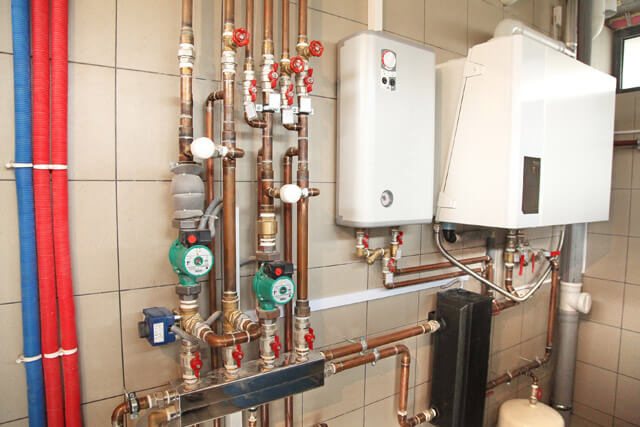

Czech and Slovak boilers are about 25% more expensive than Russian products. But they are on sale in a large model line and have wide functionality. The complete set of foreign products includes water supply and temperature sensors, pumping equipment. Also available with water tank. Their capacity is 2 times less than that of domestic ones.
Requirements for the installation of a warm floor with an electric boiler
Installing underfloor heating with an electric boiler is much easier and less time consuming than connecting underfloor heating from a gas boiler. Among the main differences are the following:
- during installation, there is no need to equip a special place for the boiler. Due to its compact size, it will fit anywhere. Moreover, an extensive range of design solutions will allow you to choose an option that will not stand out from the overall picture of the interior. If desired, you can easily hide the boiler in a separate niche or hanging pedestal;
- electric boilers do not produce any waste hazardous to health, like gas. In this connection, it does not require a chimney or special ventilation systems;
- a professional will install this device much faster than a gas counterpart;
- installation of an electric boiler does not require appropriate permits from the boiler supervision. You will not be regularly checked for compliance with security rules, which will avoid possible conflicts and inconvenient situations.
For optimal operation of the device, you will need to connect a heat storage tank. Its job is to heat additional volumes of water at night when the cost of electricity is much lower. As the coolant in the main tank loses temperature, the circulation pump will supply heated liquid from the additional tank, thereby maintaining the set temperature in the room.
Depending on the size, such a container is capable of independently heating the room from 3-4 hours to 2 days. The presence of this device is especially important if there are frequent power outages.
In addition, the heat storage tank has a list of secondary advantages:
- acts as a connecting link in a system of several boilers;
- reduces waste on electricity;
- protects the boiler from overheating;
- copes with the task of heating, in the event of an emergency power outage.
Despite the fact that the installation of a warm floor from an electric boiler is a simple process, it requires increased attention and accuracy.If the owner of the premises is familiar with an electrician at a weak level, then it is necessary to turn to professionals.
They will install the equipment in the shortest possible time and fulfill the basic requirements:
- Filling antifreeze... The use of antifreeze liquid in warm floors can reduce electricity costs by 5-10%. Sometimes distilled water with salt is used as antifreeze.
- Connection of the boiler to the power grid. The connection between the boiler and the mains must be connected to the switchboard.
- Installation of additional equipment. In addition to the above-described heat storage tank, you will also need to install residual current devices (RCDs). They protect the system from combustion in the event of strong power surges.
- Three-phase network. For boilers with increased capacities, a three-phase network is required. Connection to it is allowed only by an electrician with the appropriate permission to carry out such work.
- Installation of thermal sensors. This device is necessary so that the boiler does not work wasted when the room temperature has reached the required one. The presence of a thermostat reduces power consumption by 5-15%.
The main parameters for the selection of the unit
When choosing an electric boiler to create a warm floor, the first thing to do is to look not only at the price tag, but also at the quality of performance. Therefore, it is important to pay attention to the following points:
- The tank inside the boiler must be made of stainless steel.
- It is important that the heating element has an anti-corrosion coating.
- Insulation resistance.
- Protection against abnormal situations (for example, working without liquid).
- Heating power regulation.
In addition, you must definitely look at the manufacturer. Foreign installations most often have high-quality internal components and good assembly. Domestic boilers have a simpler device and an affordable price.
In most cases, the devices consist of:
- Heating elements;
- thermostat;
- temperature regulator;
- pressure gauge;
- starters.
Imported units in most cases have a more complex design. Most often, they also provide for such aspects as:
- smooth start;
- connecting the programmer;
- LCD display.
Knowing all the features that electric boilers have for heating a private house or apartment, you can really choose the right option. In this case, it is necessary from the very beginning to decide what role the water floor will play in home heating. If it is used as a backup, the unit should not have a pump. Better to install one for the whole system.
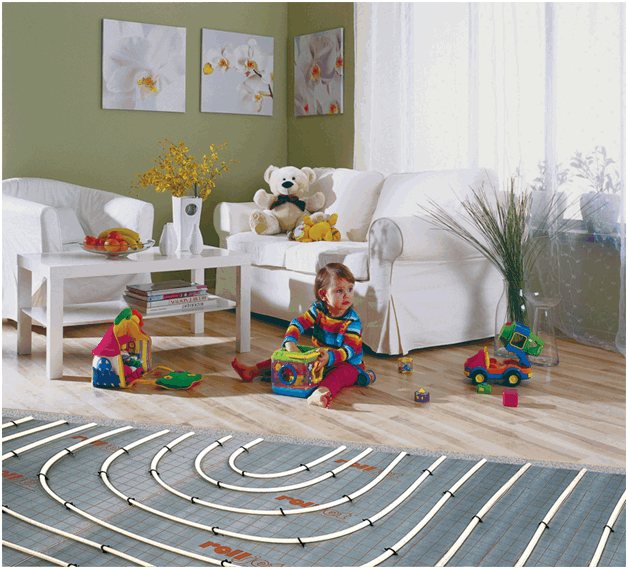

If you plan to connect an electric boiler in the immediate vicinity of a living room, it is advisable to pay attention to imported devices. They are controlled by a microprocessor for quiet operation. In addition, it is possible to connect a programmer and a thermostat to them.
